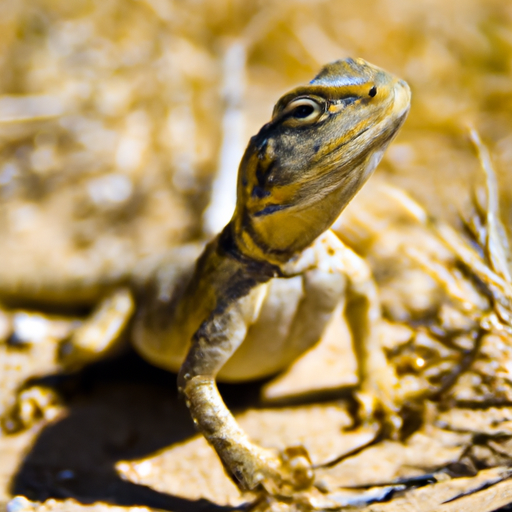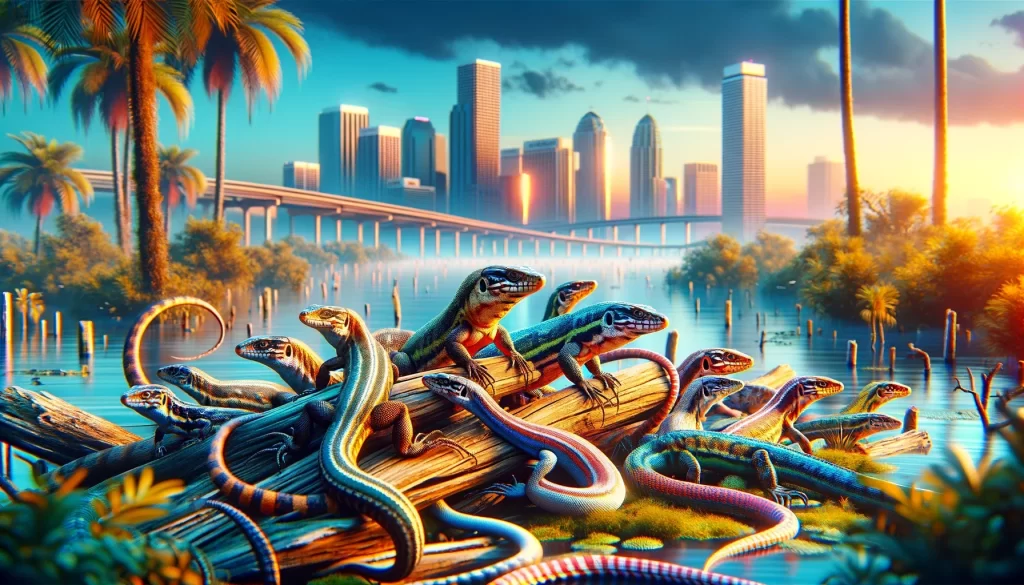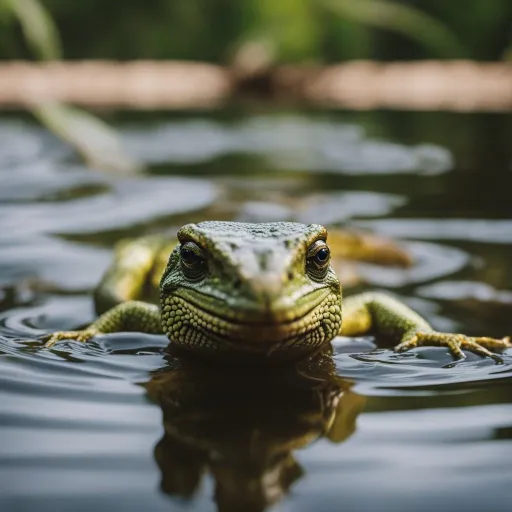Imagine you’re on a hiking trip in the blazing sun and suddenly spot a lizard scurrying across the trail. You can’t help but wonder: how long can a lizard survive without food? Well, my friend, grab a seat and get ready to satisfy your curiosity.
In this survival guide, we’ll dive into the fascinating world of lizard endurance, uncovering the astonishing lengths these resilient creatures can go without a meal.
Get ready to be amazed by their remarkable adaptations and discover just how long a lizard can truly live without a juicy insect snack.

The Importance of Food for Lizards
Imagine being a lizard, basking in the sun, darting through the grass, and exploring your surroundings. Lizards are fascinating creatures that come in various shapes and sizes, captivating us with their unique characteristics. However, like any living being, they rely on food to survive and thrive. In this article, we will delve into the importance of food for lizards, their nutritional requirements, and the signs of malnourishment they may exhibit.
Lizards’ Nutritional Requirements
To keep lizards healthy, it is crucial to understand their nutritional requirements. Lizards are ectothermic, meaning their body temperature is regulated by external sources such as the sun. This affects their metabolism and nutrient needs. In general, lizards require a balanced diet consisting of proteins, vitamins, minerals, and carbohydrates.
Proteins are essential for growth, tissue repair, and maintaining overall health. Lizards can obtain proteins from various sources, including insects, small vertebrates, and even plant material in some cases.
Vitamins and minerals play a crucial role in the lizards’ bodily functions and should be provided in appropriate quantities. Calcium, for instance, is vital for bone health and proper muscle function. Vitamin D3 is essential for calcium absorption, which can be obtained through exposure to ultraviolet B (UVB) light.
Carbohydrates are an important energy source for lizards, especially herbivorous species. Leafy greens, fruits, and vegetables are excellent sources of carbohydrates that can be included in their diet.
Energy Sources for Lizards
Lizards derive energy from different sources depending on their species and lifestyle. Herbivorous lizards primarily obtain energy from plant material due to their specialized digestive systems capable of breaking down cellulose. Carnivorous lizards, on the other hand, rely on a diet rich in protein, usually preying on insects, small animals, or even other lizards.
Some species of lizards, such as the green iguana, have evolved to efficiently extract energy from plant material by fermenting it in a specialized section of their digestive tract. This adaptation allows them to thrive on a predominantly vegetarian diet.
Signs of Malnourishment in Lizards
Proper nutrition is vital for the well-being of lizards, and inadequate nutrition can lead to serious health issues. It is crucial to recognize the signs of malnourishment in lizards to address any dietary deficiencies promptly.
Weight loss is one of the most noticeable signs of malnourishment. Lizards that are not receiving enough food may appear visibly thin or emaciated. This can be accompanied by a decrease in muscle mass and overall body condition.
Lethargy and a lack of energy may indicate a nutritional deficiency. Lizards that are not getting enough nutrients may become inactive and show reduced interest in their usual activities, such as exploring their enclosure or basking in the sun.
Skin and bone abnormalities can also be signs of malnourishment. A lack of proper nutrition can lead to conditions like metabolic bone disease, where the bones become weak and deformed. Similarly, the skin may become dry and flaky, indicating inadequate hydration and nutrition.
If you notice any of these signs in your pet lizard, it is crucial to consult a veterinarian with experience in reptile care. They can provide guidance on proper nutrition and address any underlying health concerns.
Factors Affecting the Duration Lizards Can Survive Without Food
Now that we understand the significance of food for lizards, let’s explore the factors that influence how long they can survive without it. While lizards can endure periods without food, several factors come into play, affecting their ability to cope with food scarcity.
Species of Lizard
The duration a lizard can go without food varies greatly depending on its species. Some lizards have naturally slow metabolisms and can survive for extended periods without food, while others require more frequent meals to sustain themselves. It is essential to research the specific dietary needs of your lizard’s species to ensure you are meeting their requirements appropriately.
Age and Size of the Lizard
The age and size of a lizard also play a role in determining how long they can survive without food. Juvenile lizards generally have higher metabolic rates and faster growth rates, requiring more frequent meals to support their development. Larger adult lizards, on the other hand, may have more fat reserves, allowing them to sustain themselves for longer periods without food.
Environmental Conditions
The environmental conditions in which a lizard resides can significantly impact its ability to survive without food. Warmer temperatures generally increase metabolic rates, prompting lizards to require more frequent meals. Conversely, colder temperatures can slow down metabolic processes, enabling lizards to withstand longer periods without food.
Available Water Sources
While food is crucial for lizards’ survival, water is equally vital. Lizards obtain water either through drinking or from their food sources. The availability of water sources greatly influences how long a lizard can survive without food. Limited access to water can exacerbate the negative impacts of food scarcity, leading to dehydration and further complications.
Lizard’s Health and Condition
The health and overall condition of a lizard greatly affect its ability to withstand periods without food. Lizards that are already weakened by illness or stress may have reduced metabolic reserves, making it more challenging for them to cope with food scarcity. Ensuring your lizard is in optimal health and offering a well-balanced diet is essential for its long-term well-being.
Examining Lizards’ Ability to Go Without Food
Lizards have developed various strategies to survive during times when food resources are scarce. Let’s take a closer look at these survival strategies and understand how lizards cope with limited availability of food.
Survival Strategies During Food Scarcity
Lizards’ ability to survive without food is partly attributed to their capacity to lower their metabolic rates. By minimizing energy expenditure, lizards can conserve their limited fat reserves and endure longer periods without food.
Many lizards are opportunistic feeders, meaning they can eat a wide range of food items. This adaptability enables them to switch their diet and consume whatever resources are available when their primary food sources are scarce.
Hibernation and Aestivation
Some lizard species have developed specific strategies to survive through seasons when food is scarce. Hibernation is a common strategy used by lizards in colder regions. By lowering their metabolic rates and entering a state of dormancy, lizards can sustain themselves for months without consuming any food.
In contrast, some lizard species practice aestivation, a similar state of dormancy, but during periods of extreme heat or drought. These lizards reduce their metabolic rates and become inactive, conserving energy until conditions improve and food availability increases.
Metabolic Adaptations
Lizards have evolved metabolic adaptations that can aid their survival during times without food. These adaptations may include the ability to absorb and utilize nutrients more efficiently or to store excess energy in specialized tissues or organs. These metabolic adaptations allow lizards to make the most of their food resources, enabling them to sustain themselves for longer periods without eating.
Feeding Frequency of Lizards in the Wild
In the wild, lizards typically have access to more abundant food sources than their captive counterparts. However, the frequency of feeding can still be highly variable depending on factors such as climate, predator-prey dynamics, and seasonal changes in food availability.
While some lizards may need to feed every day to meet their energy demands, others can survive with less frequent meals. For example, some larger lizard species may only require food every few days or even weeks, depending on factors such as their metabolism and the size of their prey.
Estimating the Length of Time Lizards Can Survive Without Food
Determining precisely how long a lizard can survive without food can be challenging due to the many variables involved. However, researchers and scientists have conducted studies to better understand the survival capabilities of various lizard species. Let’s explore some of their findings.
Studies and Research on Lizard Survival
Researchers have conducted studies to observe and analyze the survival capabilities of different lizard species during periods without food. By monitoring the physiological changes and tracking their survival rates, researchers have gained valuable insights into how lizards can endure food scarcity.
General Estimates for Specific Lizard Species
Based on research and observations, estimates have been made regarding the length of time certain lizard species can survive without food. For example, some smaller gecko species have been observed surviving for several months without eating, while larger monitor lizards may be capable of surviving for a couple of weeks or even longer.
Extreme Cases of Lizard Survival Records
Occasionally, extreme cases of lizard survival without food have been documented. These instances showcase the extraordinary resilience of certain lizard species. Some lizards have been found alive after prolonged periods without food, surprising researchers and emphasizing the impressive survival capabilities of these animals.

Implications for Pet Lizard Owners
For those who have pet lizards, understanding the importance of food, the duration they can survive without it, and the signs of malnourishment is crucial for their well-being. Here are some implications for pet lizard owners to consider:
Feeding Schedule and Nutrition Guidelines
Establishing a proper feeding schedule is vital to meet the nutritional needs of your pet lizard. Research the specific dietary requirements of your lizard’s species and aim to provide a well-balanced diet that includes appropriate amounts of proteins, vitamins, minerals, and carbohydrates based on their specific needs.
Avoiding Unhealthy Weight Loss
Regularly monitor your pet lizard’s weight and body condition. Sudden or significant weight loss may indicate a problem with their diet or health. If you notice any changes, consult a veterinarian specializing in reptiles to address any issues promptly.
Observation and Monitoring
Observe your pet lizard closely for any signs of malnourishment, such as lethargy, weight loss, or skin abnormalities. By being attentive to their health and behavior, you can identify potential problems early on and seek appropriate care.
Engaging a Vet for Professional Advice
A qualified veterinarian with expertise in reptile care can provide valuable guidance on your pet lizard’s specific nutritional requirements and offer advice on proper feeding practices. Regular check-ups and consultations with a reptile veterinarian can ensure your pet lizard remains healthy and thrives in captivity.
Final Thoughts
In conclusion, food is vital for the survival and well-being of lizards. Understanding their nutritional requirements, signs of malnourishment, and factors that influence their ability to survive without food can help pet lizard owners provide the best care possible for their scaly companions. By offering a balanced diet and closely monitoring their health, you can ensure that your pet lizard lives a long and healthy life.




